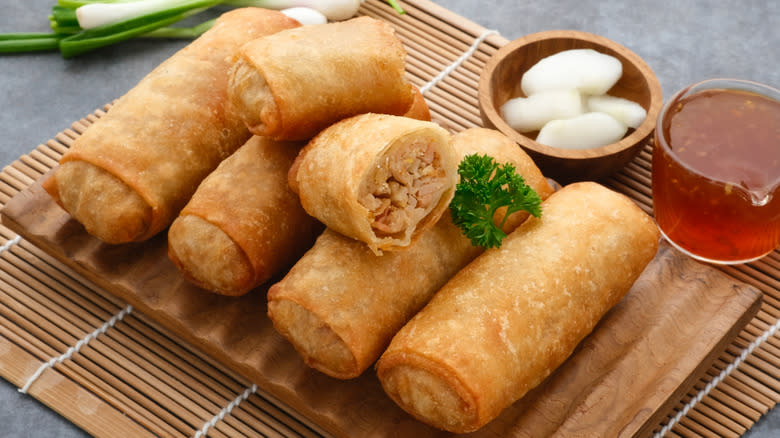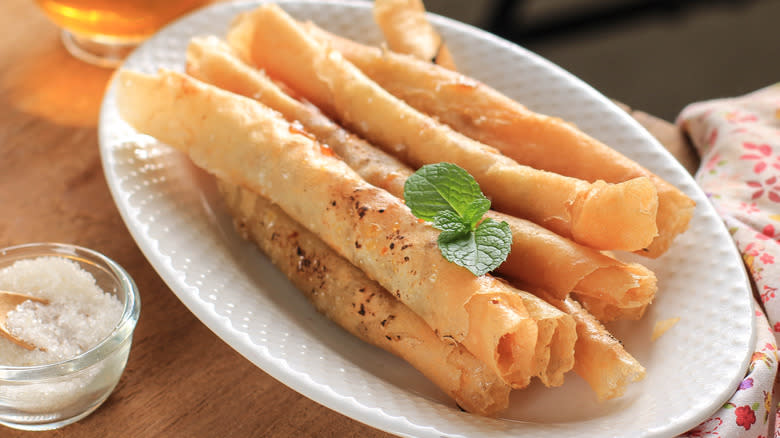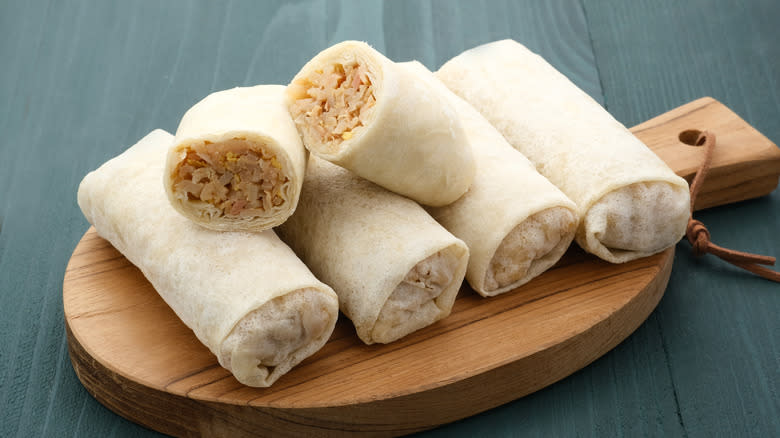What Exactly Are Filipino Egg Rolls And What Do They Taste Like?

Filipino egg rolls, also called lumpia, are a variation of spring rolls. The term "lumpia" doesn't necessarily pertain to one specifically prepared dish. Rather, the name refers to a category of food. The defining characteristic of lumpia is that its filling is wrapped in a pastry-like wrapper that's generally baked or fried until golden brown.
The wrappers used to make lumpia are ultra-thin and a bit more delicate than standard egg roll or spring roll wrappers. They're generally made from just water, flour, and a little bit of salt. Egg roll wrappers usually contain eggs, which give them a bit more structure, but lumpia wrappers omit these entirely. The sizes of prepared lumpia vary, too. While some are smaller and are meant to be served as appetizers or snacks, others are larger and can constitute a whole meal on their own.
In terms of flavor, not every lumpia is the same. Fillings can range from savory to sweet, but they're always encased in the same wrapping. They can be fried or baked to create a crunchy bite, or the wrappers can be cooked separately before filling. While some lumpia may be filled with meat and veggies for a savory snack, dessert lumpia could include fillings like fruit or chocolate.
Read more: What These Imitation Foods Are Actually Made Of
What Kind Of Fillings Go Into Lumpia?

Traditionally, savory lumpia are filled with vegetables and either pork, beef, or shrimp and are served with a sweet-and-sour dipping sauce. Because there are so many ways to change up the dish, however, you can swap in your favorite protein, or use only veggies for a vegetarian version. The fillings are often cooked before they're wrapped to ensure thorough heating.
If you're seeking to satisfy your sweet tooth, you could even turn the dish into a dessert. To make dessert lumpia, you first have to choose your sweet fillings. Chopped-up fresh fruits are a popular choice, particularly bananas or pineapples. Cans of premade pie filling can even speed up the process. Once the sweet fillings are rolled up in their wrappers, they're ready to bake or fry in oil until golden brown. After they've crisped up and cooled down, you can make a sweet dipping sauce from chocolate sauce, icing, or homemade caramel.
Lumpia Can Be Prepared Two Ways

While lumpia are most often fried to feature a crispy exterior, some prefer to roll the filling inside a separately cooked, crepe-like wrapper. These can be cooked separately in a pan until they're flat and thin. Then, the fillings are rolled up inside, and the lumpia is ready to enjoy.
The history of how lumpia came to be is a bit murky. The dish is thought to have originated in Fujian, China sometime between 618 and 907 A.D. As immigrants spread knowledge of their favorite foods, lumpia arrived in the Philippines, where it quickly became a beloved staple. From there, Filipino citizens adjusted the recipe over the years to conform to their own taste preferences.
Today, lumpia is a popular dish in the Philippines and can often be purchased as street food or in restaurants. No matter what you choose to fill your lumpia with, the dish is easily customizable and can appeal to anyone's particular taste preferences.
Read the original article on Daily Meal.

